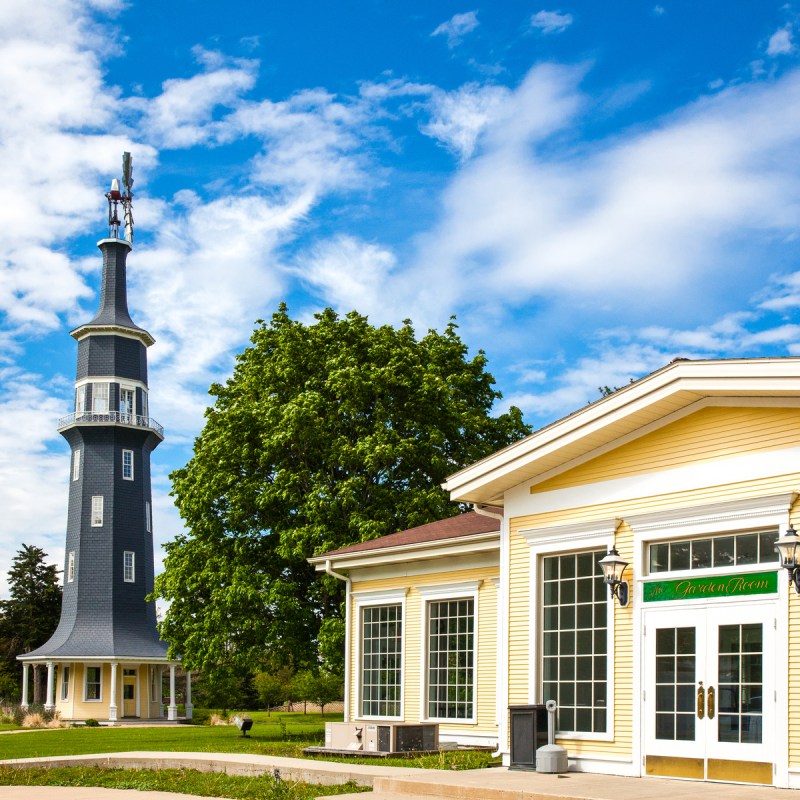
Dwight is a charming town south of Chicago filled with a unique history. While Route 66 winds through this historic downtown, Dwight is also famous because one of its residents, Dr. Leslie Keely, first recognized alcoholism as a disease. With funding from Major Curtis J. Judd, John Oughton, and a pharmacist, Dr. Keeley established the Keeley Institute. Using his famous gold “Keeley Cure” remedy along with his regime of good food, rest, and exercise, Dr. Keely created a legacy that brought droves of people to this small village. The Keeley Institute and many of its amazing buildings still stand today.
Videos by TravelAwaits
Besides Keeley history, there is the beautiful bank designed by Frank Lloyd Wright, a historic train depot, a Route 66 gas station, fun food stops, a basset hound rescue home, and the historic windmill outside the former Oughton Estate. The original Oughton Carriage House is now a lovely public library, and Dwight even sports a beautiful gothic chapel! The town has festivals a couple of times a year that have drawn me back time and again!

1. Ambler’s Texaco Station
The Ambler Texaco Station is located along part of the original Route 66. Built in 1933, the station is recognized as the longest-operating Route 66 gas station with over 60 years of continuous service! The station’s name comes from the original owner Basil “Tubby Ambler.” He operated the station from 1938 to 1966. The last owners, Phil and Debbie Becker, eventually donated the station to the Village of Dwight. Through grants and fundraising, it has been beautifully restored.
Pro Tip: The Old Route 66 Family Diner, with its cool atmosphere, is a fun place to stop and dine.

2. First National Bank Of Dwight
Originally called the Frank L. Smith Building, the First National Bank of Dwight is still operational. This is one of only two banks that Frank Lloyd Wright designed. Wright wanted the bank to be a three-story structure, but Frank Smith favored the one-and-a-half-story that it is today. The bank was designed in 1905 and opened in 1906. Outside walls of the bank are Bedford limestone. Inside, you can see Wright’s use of compressed space and view his original designs as well as some of the original lights. The staff is kind about visitors coming inside to take a peek.

3. Depot In Dwight
The Dwight Depot was built in 1891 and was needed for the increased traffic the Keeley Institute brought to Dwight. The Depot was built in the Richard Romanesque style. The foundation is composed of Joliet stone. This cool building had two waiting rooms, one at each end with the ticket office in the center. Each waiting room had a fireplace, and one is still there today. It is now the home of the Dwight Historical Society Museum. The Depot has been on the National Register of Historic Places since 1982.
Pro Tip: Not far from downtown is Cherry Red Roasters BBQ where they serve amazing food and of course barbecue. When I visited during harvest days, there was also live music!

4. Historic Windmill
The Dwight Windmill has been a draw for years because one could see it from the Amtrak when traveling to Chicago. It is unlike any windmill I have ever seen. It was part of the John R. Oughton Estate and was built in 1896. It was built by the U.S. Wind Engine Pump Company of Batavia, Illinois. The windmill’s well is 840 feet deep and the windmill has an 88-barrel cypress tank at the top of the structure. The windmill once pumped water for the entire estate. This windmill now belongs to the city of Dwight and is open for the public to view!

5. Pioneer Gothic Church
While the Pioneer Gothic Church is not open, looking at the architecture is pretty cool. The church is a wonderful example of Carpenter Gothic architecture with pointed windows and doors, and a board and batten frame construction. The steeple is 80 feet high! The church was built in 1957 by the Presbyterian church. It was used from 1891 to 1892 by the Keeley company as a clubhouse. Sold to the Danish Methodist Episcopal Church in 1893, it was later sold to the Christian Science Society, then to Mr. and Mrs. Oscar Jensen, who eventually sold it to Charles McWilliams. He gave the church to the Dwight Historical Society in memory of his Uncle Edward. The society raised money to renovate the building, and the Dwight Historical Society uses it as their Town Hall.
6. Oughten Carriage House/Prairie Creek Library
John R. Oughton Estate is on the National Register of Historic Places. After the restaurant closed, the last time I visited, it was for sale. The home was a 20-room Victorian mansion and behind it is the amazing windmill, a carriage house used for prize cattle and horses. Later, this building was converted into a treatment and recreation building. In 1989, the building was donated to the library district and now is home to the Prairie Creek Library. Inside, there is still a cool hay track rail reminding us of the original use of this lovely building.
For those seeking other Route 66 stops, the nearby town of Odell also has a fun Route 66 gas station that is also open for viewing. Dwight is also home to the Guardian Angel Basset Rescue that has thus far saved over 500 Basset Hounds. Every year during the Dwight Harvest Festival, the organization has a parade, and the hounds lead with their famous Basset waddle. Dwight has several things that put this charming town on the map. The small downtown has a few shopping options, good food, nice people, and history that is hard to beat — reasons enough to make a stop in this northern Illinois burg!
Chicago and its surroundings are great places to explore:
